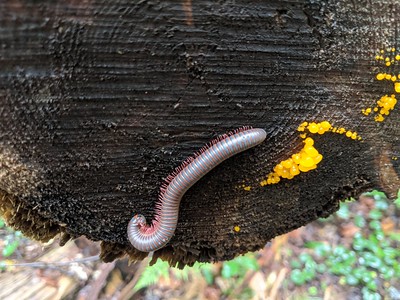
Greetings,
This is another short summary with just four articles on biodiversity (bugs in the US, global indicators, tropical moist forest quality, and bias in conservation textbooks in terms of which taxa etc. get featured).
If you know someone who wants to sign up to receive these summaries, they can do so at http://bit.ly/sciencejon (no need to email me).
BIODIVERSITY:
There have been a lot of papers documenting declines in invertebrate populations, from bees to flies, sometimes called the "insect apocalypse." But Crossley et al. 2020 use a large data set (from the Long-Term Ecological Research sites) to show that in much of the U.S., there's no clear trend (up or down). For abundance, some species are declining in some places, others are increasing, and overall the trend is pretty stable on net (See Fig 2 for details, including the exceptions to that pattern). Diversity is similarly flat on net (see Fig 3). The discussion (on the page w/ Fig 3) of possible explanations for why this paper had different results from others is interesting. They include: 4/5 sites this paper included that another seminal paper omitted showed positive trends, total abundance trends across spp. heavily weight the most numerous spp. and dwarf other changes, and this paper relied on more recent data (where others have found a decline is slowing).
Hansen et al. 2020 is a global analysis of moist tropical forest ecological quality and a great read. They use forests with high structural condition (meaning tall forests with several layers of understory trees and other plants, and high variation in plant size) and low human pressures as a proxy for overall ecological integrity (which typically also includes composition and function). The argument is that these forests have more habitat niches and can support more species, and that degraded structure is often due to stresses like logging which can have broad impacts (although they note limits of their approach up front). Fig 1 is a map w/ their results (& Fig 2 is a more helpful chart): they found 47% of remaining tropical moist forests had high integrity (both high structural condition and low human pressure, mapped as dark green), 33% had low structural condition (mapped as brown), and 20% had high structural condition but substantial human pressures (mapped as light green). 76% of the intact forest is in the Americas. In good news, forest w/ the best structure is being lost more slowly than more degraded forest (likely due to their remoteness, see fig 3). They have an ambitious suite of spatial recommendations in fig 4: extending protection to all remaining high integrity forests, plus restoration and working to reduce human pressure on the other forests.
Hoban et al. 2020 argue that new indicators are needed for a post-2020 CBD global framework for biodiversity. They recommend three new indicators: 1) # populations with effective population size above 500, 2) # current populations / # historic baseline of populations, 3) # species & populations w/ DNA-based genetic diversity monitoring, as well as keeping two existing CBD indicators (comprehensiveness of conservation of all species; and # of resilient, representative, and replicated plant genetic resources secured in medium or long-term conservation facilities). It's a fairly simple approach (albeit hard to empirically measure) for genetic biodiversity indicators.
Stahl et al. 2020 looked at 7 recent conservation textbooks and bias in what they focus on relative to natural prevalence (Fig 5 has a good summary). Some bias comes from underlying factors (research doesn't focus on species in proportion to their prevalence, more funding goes to charismatic species and richer countries), but regardless of the source they compared the proportion of examples to their prevalence on Earth. As you'd expect, the books favor examples using mammals over amphibians, North America over other continents, forests & coral reefs over other ecosystems, and tropical over temperate regions. It's an interesting topic, but there is at least one error (they claim only 3 of the textbooks mention ecoregions, but one of the other 4 discusses them at some length including an ecoregional map I created) which makes me wonder what else they could have gotten wrong (the author is looking into it and will get back to me). Ironically, the authors don't comment on potential bias in how they selected textbooks (e.g. only English language) or the methods they used (a focus on proportion of examples regardless of their value in explaining concepts).
REFERENCES:
Crossley, M. S., Meier, A. R., Baldwin, E. M., Berry, L. L., Crenshaw, L. C., Hartman, G. L., … Moran, M. D. (2020). No net insect abundance and diversity declines across US Long Term Ecological Research sites. Nature Ecology & Evolution, (Table 1). https://doi.org/10.1038/s41559-020-1269-4
Hansen, A. J., Burns, P., Ervin, J., Goetz, S. J., Hansen, M., Venter, O., … Armenteras, D. (2020). A policy-driven framework for conserving the best of Earth’s remaining moist tropical forests. Nature Ecology & Evolution. https://doi.org/10.1038/s41559-020-1274-7
Hoban, S., Bruford, M., D’Urban Jackson, J., Lopes-Fernandes, M., Heuertz, M., Hohenlohe, P. A., … Laikre, L. (2020). Genetic diversity targets and indicators in the CBD post-2020 Global Biodiversity Framework must be improved. Biological Conservation, 248, 108654. https://doi.org/10.1016/j.biocon.2020.108654
Stahl, K., Lepczyk, C. A., & Christoffel, R. A. (2020). Evaluating conservation biology texts for bias in biodiversity representation. PLoS ONE, 15(7), 1–11. https://doi.org/10.1371/journal.pone.0234877
Sincerely,
Jon
No comments:
Post a Comment
Questions, comments, suggestions, and complaints welcome.